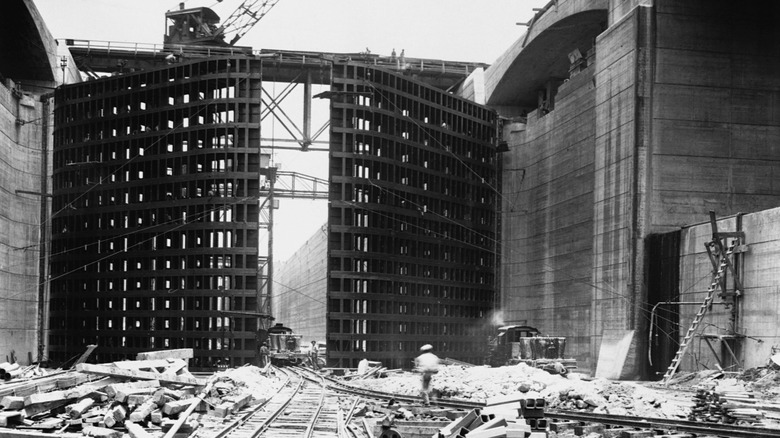How Long Does It Take For A Ship To Cross The Panama Canal?
The American Society of Civil Engineers recognizes the Panama Canal as one of the Seven Wonders of the Modern World. With its complex series of locks and massive scale, this man-made connection between the Atlantic and Pacific oceans is quite the spectacle. In fact, without making any stops, an average trip through the Panama Canal lasts between eight and 10 hours.
And it's far from free, as non-commercial boats less than 65 feet may pay close to $3,000 in tolls, while larger ships can run into the hundreds of thousands. For instance, the Orlando Sentinel reported that when one pair of sold-out Disney Cruise liners went through it, the company running the canal required the House of Mouse to pay a $500,000 total toll.
If a full day of travel and some staggering toll fees seem a bit much to ask, imagine what it was like for ships before the canal was constructed. This narrow passage through the Central American jungle saves vessels around five months, and drops as many as 8,000 miles off the trip. That's why there are as many as 40 ships crossing each day and 12,000 to 15,000 every year, per the University of Florida, and it appears that even U.S. aircraft carriers can fit through the Panama Canal.
Construction was arduous, and deadly
The French first broke ground for the canal in 1880, and over the course of two decades, over 78 million cubic yards of material were removed. Not only was the project staggering in scope, but it was also hazardous, and the French lost 20,000 workers before selling the land and the partially completed project to the U.S. in early in the 20th century. Another 5,600 died after the U.S. resumed construction.
The conditions were brutal, with temperatures routinely climbing beyond 86 degrees. The terrain was rocky, and covered with thick jungle, making progress slow and backbreaking. And these men didn't have the advantages of modern machines like the Caterpillar C175-20, which has one of the world's biggest engines that are truly massive. Many contracted illnesses like malaria and yellow fever, with some engineers only lasting a few months after arriving to Panama. There was also a devastating earthquake during construction, torrential rains that started deadly mudslides, and floods that carried away equipment.
Beyond the environment and disease, the work itself was dangerous, requiring more than 60 million pounds of dynamite. Working around loose, heavy rocks, some were accidentally crushed or lost limbs in what workers referred to as "Hell's Gorge." But the project went on, and in 1914, it opened, measuring 51 miles long and connecting the oceans at last.
Today, the Panama Canal is a popular tourist destination
There are many tours of the Panama Canal, which can span a single day or multiple days with stops along the way. The canal's Miraflores Visitor Center offers travelers an in-depth look at its history and how it works via an IMAX nmovie arrated by Morgan Freeman, as well as views of the massive ships navigating along it.
While sailing through the waterway, you get the opportunity to see lots of wildlife, as thick jungle that still spans the shoreline on both sides. The lush environment is home to so many living creatures, you might want to opt for a pair of smart binoculars that can help you identify birds. Animals like toucans, capuchin monkeys, crocodiles, brightly colored tree frogs, and even sloths can be spotted from the boat and are easy to recognize. In fact, you may want to take with you one of these digital cameras that can capture film-like photos to preserve your memories in style.


